Nail mushrooms or onychomicosis is a common problem with which each person is risked to face life, regardless of age or social status.This disease is accompanied by extremely unpleasant symptoms associated with aesthetic changes in nail and physiological discomfort.
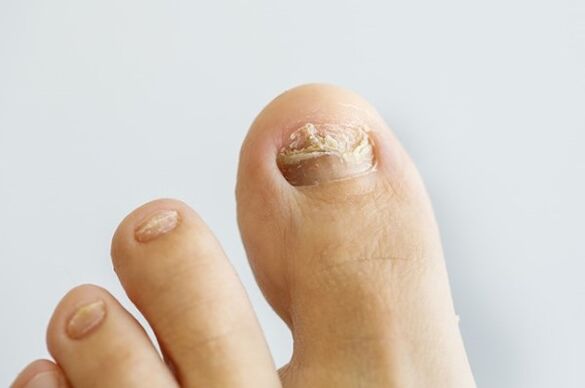
The causes of fungal nails
fungal leg damage to the legs in medical practice is much more common than similar diseases on their hands.This is due to the fact that the lower limbs are much more often in contact with a contaminated environment.In this case, the main cause of the appearance is reduced immunity.The weakened organism is unable to endure a contagious agent.
If we discuss the fungus in the nails, there are a number of factors that contribute to infection:
- visits to public places without shoes.This is especially true of baths, saunas and swimming pools, showers in the gym or manufacture, hospital departments in the hospital.In the first two cases, the risk of infection is high due to the presence of such places of people who are holders of a fungal infection.In addition, mushrooms are more active multiplied in a wet environment.Hospitals, despite compliance with sanitary standards, are a place to concentrate various infections, including fungal.He became barefoot on the floor in one of those places, the probability of getting infection grows ten times.
- In the absence of regular cleaning using aggressive chemistry, his bathroom also becomes a fungal infection plant.Even if none of the domestic ones were sick with an oncommicosis, conditionally pathogenic mushrooms living on human skin is multiplied in unclass bath.The increase in their population leads to sad consequences.
- Wearing old or other shoes - Since the conditional pathogenic mushrooms are on the skin, their entering shoes (especially closed types) are inevitable.Microorganisms are accumulated in tissue layers, which also increases the risk of infection.
- Wearing shoes does not spice - one of the infection factors is an overly sweating of the legs.If a person in summer walks in closed shoes or wears warm shoes in the room, the probability of fungal damage increases.
- Leg hygiene violation - Many people do not pay attention to lower extremity.However, periodic nail cutting and careless washing with soap may not be enough.It is important to cut nail regularly, cut confusion and push the cuticles, use special lotions and constantly clean the keratized layers of skin.
- Injuries - We are talking about fingerboard damage to the moves, bruises, cuts.In such cases, blood circulation is disturbed in the damaged area, the nail does not receive the appropriate amount of nutrients.This can cause fungus development.
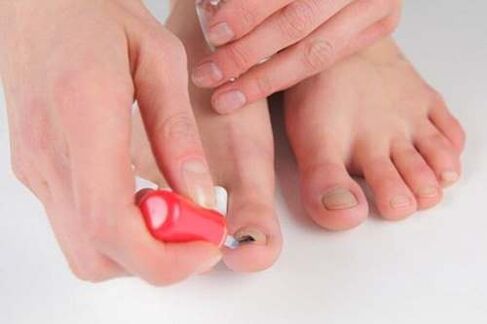
Types of mushrooms and characteristics of nail damage
Foot features depend on the identification of mushroom types that affect the nail plate.This is due to the possibility of choosing medications that show activity in relation to a certain type of pathogenic and the implementation of the most efficient treatment.
Dermatophytes
The most common type of pathogen.According to statistics, dermatophytes cause a fungal on nails about 75-80% of cases.In this case, the state of the immune system takes the main role in the appearance of an oncommicosis.With normal immunity, fungal damage dermatophytes is almost impossible.
The infection comes from people or animals that are carriers, as well as in contact with soil.Certinocyes, cellular structures of the epidermis, whose high content observed in nails are a favorite medium nutrition of this type of mushroom.
The two main subspecies vary in the casto dermatophyte, the most common pathogene ashomycosis:
- The beginning of the pathological process occurs at the end of the (external) part of the nail, from where the infection gradually switches to the root nail plate.In most cases, this is this underfounding that affects the toes.It is characterized by simultaneous nail damage to several fingers (often standing nearby).Characteristic signs of infection are a thickening of the affected area of the nail and its delamination.The skin under the external Facet Nailboard is dried and peeling.
- Trichophyton is intergrass - in this case the white surface of onyhycomicosis is developing.Favorite habitat is wet, often located in bathrooms, bathroom, swimming pools.Cancel agent more often affects the thumbs of the lower extremities, followed by "captures" other nails.The characteristic characteristic is considered focal pain damage to nail plates with the appearance of separate white spots or tapes.In the future, whitish parts grow, merging together.When monbilic life forms are spreading to other fingers, there are areas of dried and peeled leather between the fingers.
Quas
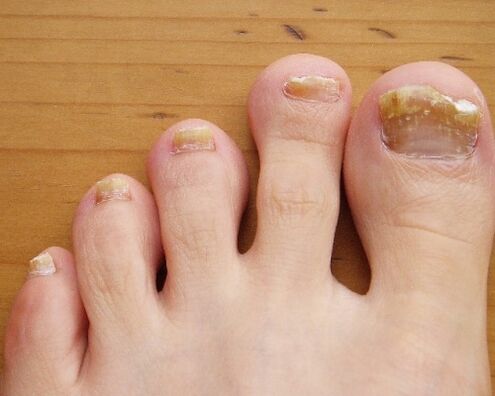
Another pathogen of fungal leg damage is conditionally pathogenic mushrooms from the Candida family.They are considered conventional and pathogenic due to the fact that they constantly live on the surface of human skin.It's for infection, contact with an infected person, an animal or external environment should not at all.In this case, the main trigger of pathology is a significant decline in immunity, immunodeficiency.
Unlike dermatophytes, yeast mushrooms do not form a layer of micellium, ie the destruction of nail plate with this form of damage occurs much less often.But the same factor makes the contagious lesion as hard as the beginning of the pathological process takes the root (proximal) side of the nail.Such varieties of mycoze are considered heavier, but at the same time rare.
The first characteristic feature of the pathological process caused by the yeast mushrooms is separating the upper layer of nail plate.Therefore, the nail loses shine, becomes boring and rough.Damage to nails with yeast mushrooms occur in about 7-10% of cases.
Molds of the wise type of mushroom, as these forms of life are located almost everywhere (but especially in a wet environment).Fungal nail damage to the leg can cause about 35-40 mold subspecies.
Despite the prevalence in the environment, this form ofychomicosis is rarely diagnosed.Partly, as well as because of the atypical clinical image, the mold is harder to diagnose and treat.Another reason for the diagnosis of mold ofychomicosis is the ability to form a mushroom, which makes the clinical picture, and the fungal of the dermatophyte is about 10-15%.
Clinical picture
Most types of nail plates are progressing slowly.On the initial phases of fungi can be unnoticed at all.But there are still symptoms of the early stages of pathology development, which are important to pay attention to:
Većina vrsta gljivičnih oštećenja na pločima za nokte napreduju polako. Na početnim fazama gljiva može uopće ostati nezapažena. Ali ipak postoje simptomi ranih faza razvoja patologije, koja su važna da obratite pažnju na:
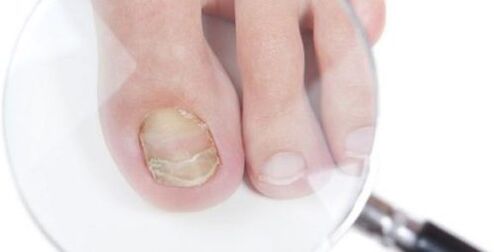
- Breaking growth is the first and most intense sign.In a state of norm, the nail on the leg grows for no more than 2 mm per week.The nail plate, affected by fungi slows the growth speed.
- Color change - First of all, nails affected by fungi faded, lose shine, becoming matte.It also notes the appearance of white or yellow intertwined on the nail surface or complete coloring boards for nails (white, yellow or shades of brown).Change the color from the nail fungus in the upper photo.
- The formation of burdum and damage and the cuticle is another indirect attribute that indicates the lesion of the mushroom of nearby skin.If you start the bandage more often, and the area of the cuticle is systematically inflamed or damaged, it is worth checking for a fungal lesion - variations depend on damage to the specific mushrooms.
- As the path effects, the symptoms become more obvious, it is harder to ignore it.Clinical signs of the later phases include:
a change of nail plate surface - becomes rough and uneven, intermittent from tubercles and waves.They can also appear on the nail, the similarities of crumbs, indicating the gradual detachment of the upper nail.
- At even later stages, the nails are gradually being collapsed.It is initially expressed in the stratification of nail plate, the appearance of cracks on the entire surface or chips on the outer edge.It looks this feature of the fungus on the leg nails in the photo.
- In the future, the destruction is even harder.The nail literally decomposes, not for growth time.At the same time, the subset parts of the dermis are exposed, and the remaining nail parts look clearly painful and unattractive.As a result, there is a risk of complete destruction or separation of nail plate.Heavy lesion with nail fungal on the above photo.
Danger of complications
Many unpleasant sensations and deterioration of the appearance of the nail legs are just the tip of the iceberg.The lack of timely treatment is threatened to develop complications, among which allergic reactions, the body's legs may experience the body's immune system, including systemic.
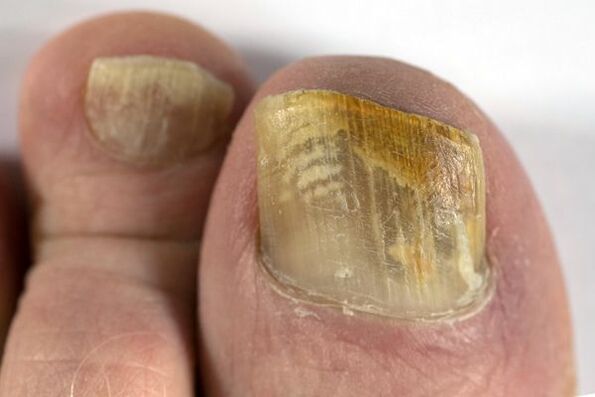
- Lack of drugs to join other infections affected areas.As a result, inflammatory and purulent processes are developed.
- Especially difficult cases, subject to extended course and promotion of the disease, can lead to the development of fungal mycosis.In this case, mobile life forms can penetrate the blood and will be distributed throughout the body.
- Treatment methods
- for maximum finger fungal treatment efficiency is often used complex therapy.At the same time, it is previously important to implement diagnostics of sowing in the bacterial environment to determine the type of pathogen and selection of most efficient drugs.Integrated access includes a combination of several types of therapy, but sometimes it is not enough.
Medications
medications are the basis for the treatment of most pathologies, including fungal nail lesions.Two main drug groups are used as part of the treatment, depending on the stage of the development of the pathological process:
Terapija lijekovima je osnova za liječenje većine patologija, uključujući gljivične lezije noktiju. Kao dio tretmana koriste se dvije glavne grupe lijekova, ovisno o fazi razvoja patološkog procesa:
- Local type of action - These include ointment, gels, varnishes, creams, sprays and lotions with antifungal activity.The method, the multitude and duration of the use of such drugs determine the doctor, but in most cases, at least 2-3 weeks are used.
- Systematic antimocycases - are needed for nail fungal treatment in later phases of progress.These are mostly pills, which, after sucking from the gastrointestinal tract, penetrates the blood and inhibit wings of fungal life, and also does not allow Micoza to spread.The use of the system is important not only to improve the therapeutic effect, but also for the purpose of preventing relapse.
National medications
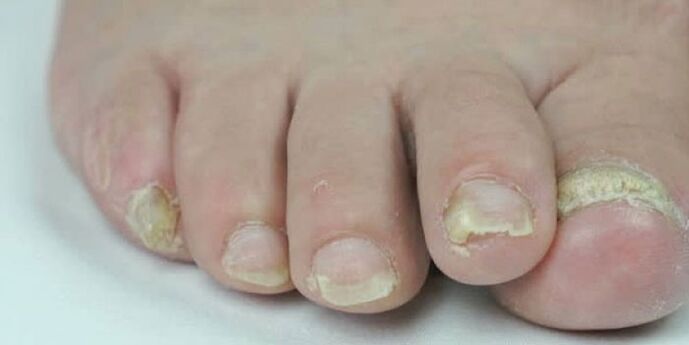
Traditional medicine is considered auxiliary method of combating fungus on their feet.National recipes can improve antifungal effect.The most efficient of them are considered:
- iodine - is able to dissolve protein structures, which are the basis of fungal life forms.For treatment a day, apply a few drops of iodine to affected areas with cotton pillow.
- Peroxide is an effective antibacterial tool that has disinfectic effects.To improve the effect, peroxide is mixed in equal proportions with vinegar.Then the patient is lubricated with a mixture, it is not necessary to escape.The procedure is repeated daily for 1-2 weeks.
- Celandin - The best method of using this plant for fumes on leg nails are Poulters.To do this, drink a spoon of crushed raw materials (sheets and twigs), pour 0.5 liters of water and bring to the boil.The decoction is defended within 15-20 minutes, after which the legs were invested in another 20-25 minutes.Repeat the procedure everyday before bed 2-3 weeks.
Removing the nail
Today in medical practice, the main chemical method of removing nail plates is used in medical practice.For this, special aggressive medications are used, the procedure is carried out by a doctor so that it does not harm healthy areas of nail and leather plates.This method is painless and efficient, and indications for its use are the absence of the results of conservative treatment or advanced cases of-off of onychomicosa.
Laser therapy
The procedure includes partial or full removal of nail plate.The choice of method depends on how deep fungus penetrates in the nail structure.During laser therapy, an intensive laser irradiation method is used.The special apparatus is removed with the nail slots, followed by an antifungal therapy course.

Fully removal of the laser nailboard should be fully influenced by the Fungi completely, in the base.In this case, after removal, the bend is applied to naked leather areas, under which the fat or cream with an antifungal effect can be deposited.Nailboard removal requires regular visits to the doctor to complete the growth of the new nail panel, during which only a few layers of the nail, within 7-10 minutes are required to process each nail).If removal is displayed, the procedure gives up and lasts about 20 minutes, the patient does not feel pain.

















